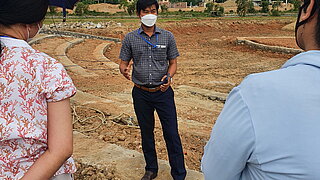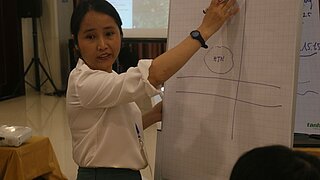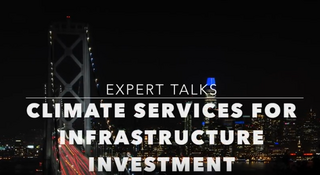Infrastructure practitioners unite to reduce climate risks

The CSI project helps its partners to make climate-risk informed decisions and have currently launched an International Practitioners Network on climate risk and vulnerability assessments for infrastructure.
The IKI project „Enhancing Climate Services for Infrastructure Investments (CSI)” works with its partners to help them make climate-risk informed decisions about their infrastructures. The project and its partners have currently launched an International Practitioners Network on climate risk and vulnerability assessments to ensure continued peer learning and exchange.
Infrastructure-decision makers face the challenge that decisions taken on infrastructure today will shape how our societies will be able to cope with the impacts of climate change decades from now. They are looking for ways to ensure infrastructures are ready for this.
One of the people facing this challenge is Mr. Dien from Vietnam. He works for the Water Resources Investment and Construction Board 10 (PMU-10) under the Ministry of Agriculture and Rural Development (MARD). As construction manager, he has been in charge of the construction of the biggest sluice gate system of Vietnam: Cai Lon - Cai Be. The system is one of 56 sluice gates protecting Kien Giang province from saltwater intrusion and flooding. Before Cai Lon – Cai Be was built, one of the main concerns of the Vietnamese Government had been how to ensure that the sluice fulfils its service functions over the next 100 years and that the investment is not lost.


In 2005, infrastructure decision-makers in Canada were facing the same question. In response, the Public Infrastructure Engineering Vulnerability Committee (PIEVC) was created and developed a climate vulnerability and risk assessment methodology for infrastructure, with initial funding from the Canadian Federal Ministry of Natural Resources. Known as PIEVC Protocol (PIEVC Program), the methodology guides practitioners through a step-by-step process of vulnerability and risk assessment. Based on this process, users can prioritize among risks and identify potential adaptation actions, to help ensure funds available for adapting infrastructure to the impacts of climate change are effectively spent.
From Canada to Vietnam – the PIEVC Protocol
When the CSI project was looking into ways to support partners like Mr. Dien in Vietnam in making climate-risk informed decisions, the PIEVC protocol was a perfect fit. Since the project started in 2017, more than 300 people in its partner countries Brazil, Costa Rica, Vietnam, the Nile Basin Initiative (NBI) and beyond have learned how to use the PIEVC through practical applications and trainings. With its participatory approach, the PIEVC brings together engineers, climatologist and other infrastructure practitioners. Through this, it makes use of local knowledge and builds local capacity at the same time.
One example for this has been the risk assessment conducted for the Cai Lon – Cai Be sluice gate system in Vietnam. Mr. Dien explaining on how the participatory process of the PIEVC helped to overcome data gaps says, “We invited the expert from MONRE (referring to the Vietnamese Hydro-Meteorological Service which is part of the Vietnamese Ministry for Natural Resources and the Environment) and solved the data problem this way”. For institutions like the Hydro-Meteorological Service (HydroMet), applying the PIEVC is often the first time they are involved in climate risk assessment processes.
Ms. Lien from the Southern HydroMet service in Ho Chi Minh City has worked closely with Mr. Dien during the risk assessment process. The process helped her to understand the importance of climate risk assessments and the role of HydroMets.By bringing together actors that had not cooperated closely before, the PIEVC helps shaping networks across institutions that support the bigger national adaptation process.
International Practitioners Network on climate risk and vulnerability assessments
How can Ms. Lien and Mr. Dien continue this process and share their lessons learned on using climate risk assessments with practitioners from other parts of the world? To spread capacities on climate risk assessments for infrastructure further and continuously expand the toolkit, the International Practitioners Network on climate risk and vulnerability assessments has been founded. It allows decision-makers and practitioners like Dien and Lien to connect with their peers from around the world to access expertise, learn and advance practice related to climate-resilient infrastructure together. The network does not only provide access to international experts and trainings but also facilitates south-south exchange.
The launch is accompanied by a webinar-series covering different aspects related to climate-resilient infrastructure. The series will be followed by an in-person international conference in Canada in April 2023 that will connect the extensive application experience in Canada to the blooming international PIEVC practice.
CSI is implemented by Deutsche Gesellschaft für Internationale Zusammenarbeit (GIZ) GmbH on behalf of the German Federal Ministry for Economic Affairs and Climate Action (BMWK) andn cooperation with the Climate Risk Institute (CRI). GIZ, CRI and the Institute for Catastrophic Loss Reduction (ICLR) are also the institutions comprising the PIEVC Alliance that took over the stewardship of the PIEVC in 2020.
The link has been copied to the clipboard
Contact
IKI Office
Zukunft – Umwelt – Gesellschaft (ZUG) gGmbH
Stresemannstraße 69-71
10963 Berlin
Registration for online seminar series
Climate Change Vulnerability and Risk Assessments for Infrastructure – Climate Risk Institute
Presentations on the topic
The CSI project presented its work at an IKI Brown Bag Luch event. Here you can find the presentations:
PIEVC - Protocol and Program: Background, Status, New Directions
A second presentation will be added shortly.


















